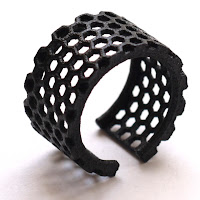Alia Hasan is a designer living and working in San Diego. She was born in Burlingame, California — a suburb of San Francisco — and got a degree in architecture from the University of California at Berkeley. After interning at various architecture firms she went on to a three year graduate program at UCLA and worked for modernist architect Mark Mack on projects that ranged from the scale of a guest house in Sonoma County to a competition for a new housing development in Pangyo, Korea (in which the firm won first place).
Her current work is focused on design of a different scale entirely. She is interested in using digital fabrication techniques to create designs that incorporate elements of architecture — such as form, surface, and geometry — applied to the scale of jewelry. Last year, this interest led her to create Archetype Z Studio.
"Archetype Z Studio was started," she explains, "as a way to explore smaller scale design work. I have degrees in Architecture from Berkeley and UCLA, but I've always had an interest in smaller scale design like product and jewelry design. Whereas in architecture one often spends years developing a single design for a single client, in jewelry design one can develop multiple designs for (potentially) the masses. The idea that innovative modern design can be accessible to all is a powerful and appealing concept that I find difficult to resist.
"Though I occasionally create entirely handmade items, my work has an increasing focus on digital fabrication like 3D printing and lasercutting which allow me to create from almost limitless design possibilities. In the same way that computers opened up design possibilities to architects in the 1990s, rapid prototyping is now opening up design possibilities to product and jewelry designers in ways never before imagined. I'm intrigued by the idea of jewelry pieces not having to be conventional in any sense — that a bracelet does not have to be a circular bangle that merely hangs from the wrist, but instead an irregular surface that drapes it. 3D printing makes that possible. It allows me to focus on texture, form, surface and patterns, rather than the constraints of conventional jewelry making. Yet even with digitally fabricated designs I prefer to have some sort of personal handling (sanding, polishing, assembling, etc) before passing each item on to its future owner. It gives me the sense that my designs are real and couldn't exist without me."
You can find Hasan's work available for purchase here.
"Archetype Z Studio was started," she explains, "as a way to explore smaller scale design work. I have degrees in Architecture from Berkeley and UCLA, but I've always had an interest in smaller scale design like product and jewelry design. Whereas in architecture one often spends years developing a single design for a single client, in jewelry design one can develop multiple designs for (potentially) the masses. The idea that innovative modern design can be accessible to all is a powerful and appealing concept that I find difficult to resist.
"Though I occasionally create entirely handmade items, my work has an increasing focus on digital fabrication like 3D printing and lasercutting which allow me to create from almost limitless design possibilities. In the same way that computers opened up design possibilities to architects in the 1990s, rapid prototyping is now opening up design possibilities to product and jewelry designers in ways never before imagined. I'm intrigued by the idea of jewelry pieces not having to be conventional in any sense — that a bracelet does not have to be a circular bangle that merely hangs from the wrist, but instead an irregular surface that drapes it. 3D printing makes that possible. It allows me to focus on texture, form, surface and patterns, rather than the constraints of conventional jewelry making. Yet even with digitally fabricated designs I prefer to have some sort of personal handling (sanding, polishing, assembling, etc) before passing each item on to its future owner. It gives me the sense that my designs are real and couldn't exist without me."
You can find Hasan's work available for purchase here.
























0 comments:
Post a Comment